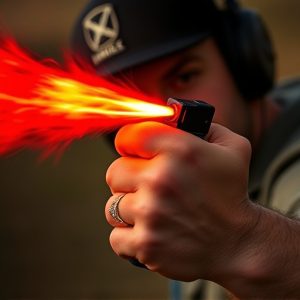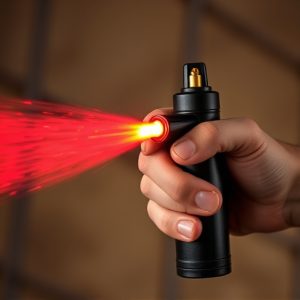Pepper Spray Dispenser Units: Components, Safety & Eye Washing Procedure
The Pepper Spray Eye Washing Procedure is a critical safety step after using pepper spray for riot c…….
The Pepper Spray Eye Washing Procedure is a critical safety step after using pepper spray for riot control, aiming to dilute and wash away oleoresin capsicum (OC) residue. Riot control units feature durable canisters, precise triggers, and eye-washing stations. In case of exposure, immediate eye washing with clean water for 15 minutes is vital; moving away from the source first, then gently flushing both eyes helps alleviate discomfort and prevent potential damage. Strategic deployment and safety protocols, including proper gear and clear communication of the procedure, are essential to ensure public safety while using riot control pepper spray effectively.
“Discover the powerful tool that is riot control pepper spray and its unit components in our comprehensive guide. With an emphasis on understanding the active ingredient’s effects, this article delves into the essential elements of a dispenser unit. We also explore critical safety measures, including effective eye washing procedures after exposure to pepper spray. Learn about strategic deployment and key considerations for law enforcement and security personnel, ensuring the safe and responsible use of this potent tool.”
- Understanding Pepper Spray: The Active Ingredient and Its Effects
- Components of a Riot Control Pepper Spray Dispenser Unit
- Effective Eye Washing Procedure After Pepper Spray Exposure
- Deployment Strategies and Safety Considerations for Riot Control Pepper Spray Units
Understanding Pepper Spray: The Active Ingredient and Its Effects
Pepper spray, a common riot control agent, is designed to disable and disorient individuals temporarily. The active ingredient, typically oleoresin capsicum (OC), is derived from chili peppers. When sprayed, OC irritates the eyes, nose, and respiratory system, causing tears, coughing, and difficulty breathing. This disruption can help law enforcement manage chaotic situations by subduing and separating rioters or protesters.
The Pepper Spray Eye Washing Procedure is a critical component of safety when using this agent. After exposure, affected individuals should immediately seek clean water for eye washing. This step helps to dilute the pepper spray residue, alleviating irritation and potential damage. Prompt and thorough eye washing is essential in minimizing discomfort and ensuring the fastest possible recovery.
Components of a Riot Control Pepper Spray Dispenser Unit
A riot control pepper spray dispenser unit is a specialized piece of equipment designed for law enforcement and security personnel to manage chaotic situations effectively. The primary component, naturally, is the pepper spray itself—a potent irritant that temporarily disables individuals by causing tears, pain, and difficulty breathing when sprayed into the eyes and respiratory system.
Complementing this crucial element are various other parts that ensure precise and controlled deployment. These include a durable housing or canister to contain the spray, a trigger mechanism for releasing it, and often, an integrated eye-washing station following the pepper spray eye washing procedure. Some advanced units may also incorporate GPS tracking, alarms, and safety features designed to minimize risks during use, ensuring the quick and safe resolution of riotous or aggressive scenarios.
Effective Eye Washing Procedure After Pepper Spray Exposure
In the event of pepper spray exposure, immediate and proper eye washing is crucial to minimize discomfort and potential damage. If your eyes are affected by pepper spray, it’s important to act swiftly. First, move to a safe location away from the source of the spray to prevent further irritation. Then, gently flush both eyes with clean, running water for at least 15 minutes. The flow should be steady and continuous, ensuring every part of your eye comes into contact with the water. This thorough washing helps to dilute and wash away the irritants.
Remember that the pepper spray’s active ingredients can cause significant irritation and even temporary blindness. Therefore, a swift and effective eye washing procedure is vital. It’s recommended to use clean, fresh water if possible, as contaminated water may introduce additional impurities. After flushing, you should seek medical attention if symptoms persist or if any signs of infection develop.
Deployment Strategies and Safety Considerations for Riot Control Pepper Spray Units
When deploying riot control pepper spray units, a strategic and well-coordinated approach is essential to ensure maximum effectiveness while minimizing risks. One key strategy involves assessing the size and nature of the gathering or protest. For smaller groups, targeted bursts of pepper spray can effectively disrupt and disperse them, with less risk of harm or excessive use. In larger crowds, a more gradual deployment might be necessary, allowing for an orderly retreat rather than a chaotic dispersion.
Safety considerations are paramount when handling riot control pepper spray. Essential safety protocols include providing adequate eye washing stations at the site to mitigate risks associated with pepper spray inhalation or contact. The Pepper Spray Eye Washing Procedure should be clearly communicated and easily accessible to all personnel. Additionally, ensuring proper ventilation in enclosed spaces is crucial to prevent buildup of irritants. Trained personnel equipped with protective gear are vital to manage the deployment, offering a balance between maintaining public safety and preventing excessive force or harm to individuals within the affected area.
In conclusion, riot control pepper spray dispenser units are powerful tools designed to manage crowd control situations effectively. Understanding the active ingredient, its effects, and proper deployment strategies is crucial for ensuring safety. Additionally, knowing the appropriate eye washing procedure after exposure to pepper spray is essential in mitigating its impact. By adhering to these guidelines, first responders and law enforcement can maximize the unit’s potential while minimizing risks associated with its use.


